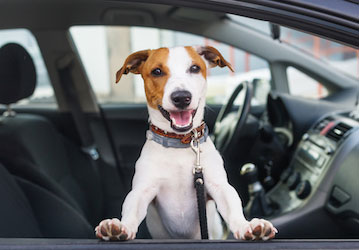Pets are wonderful companions, and you can benefit in so many ways: They can get you out exercising, increase your self-esteem, decrease a sense of isolation, and help you through tough times. For active-duty families, though, frequent moves can sometimes make it tough to take your four-footed family members with you. And for those military families who are facing a deployment, a pet might contribute additional stress for those at home to manage. In either case, it’s important to plan ahead and be prepared, so you and your pets are ready for whatever comes your way.
The benefits of owning a pet
Pets foster feelings of emotional well-being and help manage stress. And there’s a growing body of research on the use of dogs to provide therapeutic benefits to those coping with post-traumatic stress disorder and traumatic brain injury. Pet owners who become aware of the effects of their own high-risk behavior on their pets are often motivated to make healthy behavior changes such as quitting smoking. Dog ownership, especially, motivates people to get more physical activity—from daily walks to playtime in the park to participation in agility trials. Dog owners, in fact, are more likely to meet physical activity guidelines than those who don’t have dogs. Pet ownership also can encourage social activity, whether it’s talking to fellow pet owners, meeting people on the street or at a training class, or participating in pet-related activities (dog shows, cat shows, “bark in the park,” “yappy hour,” and more).
Children especially benefit from the presence of pets in the family, even more so for those with a single parent (including temporarily due to the deployment of one parent) or without siblings. For military kids, pets also can provide consistency and companionship across relocations.
Preparing for a pet
Before you bring a pet into your family, be aware of the expenses associated with pet ownership. Food is the cheapest recurring expense. Just as with people, pets need regular medical checkups and shots. They also can get sick or injured, and the veterinary expenses can be considerable. Flea and tick preventions aren’t cheap, either. The unanticipated expenses of pet ownership are among the major reasons that so many animals end up in shelters. Look before you leap, and make sure you can afford to keep a pet before you bring one into your life.
As a Service Member, if you have a pet—or decide to get one—you’ll need to think about what happens when your duties take you away from home. Consider the following planning strategies you’ll need to address when you’re getting ready for a PCS or a deployment.
When you PCS
- Finding new pet-friendly housing is perhaps one of the biggest problems for families that relocate frequently. For families that rent, online resources can help you find rentals that permit pets.
- If you’re able to reach your new duty station by car or truck, bringing along your four-footed family members is relatively straightforward. An online search should help you find plenty of pet-friendly hotels along your route for overnight stops if you don’t have your own RV or camping setup. Just make sure to have the right-size crates to keep your traveling companions safe and as comfortable as possible. Remember to stop regularly along the way for rest stops, walks, and bathroom breaks.
- If you’re flying to a new location, consider the time of year or weather, length of flight, and airline prices for pet transport. You’ll also want to research airline policies and look into things such as animal size limits, if your pet can travel in the main cabin, and criteria for airline-approved kennels. Another good option is to look for a reputable vehicular pet-transport company if you aren’t relocating overseas. Either way, ensure your pets have collars with identification and rabies tags (and a microchip if possible), and keep copies of their latest health papers with you, especially if traveling internationally. To learn more about pet travel, visit the U.S. Department of Agriculture Animal and Plant Health Inspection Service web page.
Before deployment
- Make a plan. If you’re single and have to leave a pet behind—permanently or temporarily—ask a family member, friend, or foster caregiver you trust to care for your pet. Also, have a written agreement that specifies an alternative caregiver, liability for damage, responsibility for veterinary expenses, and what happens if you can’t reclaim your pet.
- Assign “pet duty.” It can be challenging for military families to manage taking care of pets on top of other responsibilities while their Warfighter is deployed. Dogs in particular need daily attention such as walking, feeding, and training. Other pets might require more passive care, but your family members will still need to incorporate time into their schedules to care for a pet on a regular basis. If your Warfighter manages pet responsibilities when home, they will have to be reassigned at times to other family members.
- Explore pet-friendly resources. Several non-profit organizations exist to help Service Members with pets, including Dogs on Deployment, Guardian Angels for Soldier’s Pet, Pets for Patriots, PACT for Animals, Operation Military Pets (part of SPCA), and others. Some of these can even accommodate pets during a PCS or deployment. Before you leave, make sure all shots are up to date, and leave a packet of veterinary information with your pet’s caregiver. You’ll feel more comfortable having to say goodbye...for now.
